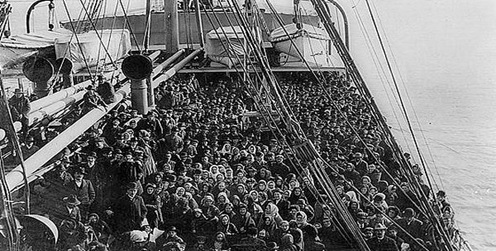
The National Museum of the American People’s third chapter covering the period from 1820 to 1924 saw a slow but steady stream of immigrants to the U.S. up to the Civil War, predominantly from Western Europe, especially from Germany and Ireland.
In the wake of the Civil War, the Constitution was amended to abolish slavery, make all persons born or naturalized in the U.S. citizens, and prevents the U.S. from denying the vote due to race, color or previous condition of servitude.
As the Industrial Revolution gathered steam during the second half of the 19th Century and early 20th Century, immigration soared. Newcomers were now arriving in large numbers from southern, central and eastern Europe as well as eastern Asia.
The first immigration law enacted during this period was the Naturalization Act of 1870 that allowed aliens of African nativity and persons of African descent to become U.S. citizens.
In 1875, the Page Act became the first immigration law to exclude a group from entering the country. In this case it was Chinese contract laborers and it was the first of many laws discriminating against Asians. Seven years later the Chinese Exclusion Act banned skilled and unskilled laborers and Chinese employed in the mining industry from entering the country for 10 years and denied Chinese immigrants a path to citizenship.
Then in 1888 the Exclusion Act was amended to ban Chinese workers from re-entering the U.S. after they left. For years after that Chinese laborers were required to carry a resident permit at all times or face deportation or a sentence to hard labor. The citizen ban was also extended for another 10 years.
In 1907 the so called “Gentleman’s Agreement” between the U.S. and Japan ended the immigration of Japanese workers. The Immigration Act of 1917 instituted still more restrictions of people from Asia and the Pacific Islands.
While these anti-Asian laws were being promulgated over a period of more than 40 years, the U.S. passed laws during that same period excluding people engaged in a host of activities including criminals, prostitutes, anarchists, convicts, polygamists, beggars, and those who committed crimes of “moral turpitude.”
Also excluded were persons with a range of perceived characteristics or conditions. Various U.S. laws specifically mentioned: lunatics, idiots, persons likely to become public charges, the mentally ill, those with contagious diseases, epileptics, imbeciles, feeble-minded people, those with physical or mental disabilities, tuberculosis victims, children without parents, homosexuals, insane persons and alcoholics.
In 1907 a law was passed that said that women must adopt the citizenship of their husbands thus losing their U.S. citizenship unless their husbands became citizens. That law was repealed in 1922.
The Immigration Act of 1891 created the nation’s first agency dedicated to immigrants, the Bureau of Immigration in the Treasury Department. It also called for the deportation of people who entered the country illegally.
Ellis Island opened in 1892 and became the nation’s primary immigration station until it closed in 1954. It is estimated that 40% of Americans have a relative who passed through Ellis Island.
The Bureau of Immigration and Naturalization was created in 1906 and placed in the Commerce Department and in 1924 the U.S. Border Patrol was created.
This chapter of the story told by the National Museum of the American People ends with major laws passed in 1921 and 1924 closing the doors to immigration. While more than a million immigrants arrived in the U.S. during the peak years of this chapter, the Emergency Quota Law of 1921 limited the number of immigrants to the U.S. to 350,000 a year and implemented a nationality quota of 3% of the population of particular nationalities based on the 1910 census. This greatly reduced immigration from eastern and southern Europe.
The National Origins Act of 1924 reduced the number of immigrants allowed to enter the U.S. each year to 165,000 and set the nationality quota at 2% based on the 1890 census. While this quota system did not apply to immigrants from the Western Hemisphere, new immigrants practically disappeared until World War II. We will pick up those laws in the next blog.
This blog is about the proposed National Museum of the American People which is about the making of the American People. The blog will be reporting regularly on a host of NMAP topics, American ethnic group histories, related museums, scholarship centered on the museum’s focus, relevant census and other demographic data, and pertinent political issues. The museum is a work in progress and we welcome thoughtful suggestions.
Sam Eskenazi, Director, Coalition for the National Museum of the American People
